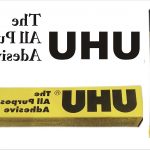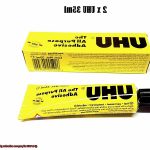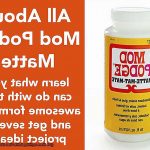If you’re into woodworking, you know that picking the right glue is key to keeping your creations together.
Wood glue is a popular choice because it’s known for its strong hold. But here’s the burning question: is wood glue acidic or alkaline?
We’re diving deep into the world of wood glue to uncover its chemistry, pH level, and how acidity or alkalinity can affect how well it sticks. Get ready to learn all about the acidity of wood glue and how it can make or break your woodworking projects.
Let’s get started.
What is Wood Glue?
Contents
- 1 What is Wood Glue?
- 2 Composition and Properties of Wood Glue
- 3 Is Wood Glue Acidic?
- 4 Measuring the pH Level of Wood Glue
- 5 Acidity of Wood Glue Compared to Other Substances
- 6 Reason for the Slight Acidity in Wood Glue
- 7 Does Acidity Affect Woodworking Projects?
- 8 Proper Surface Preparation for Adhesive Joints
- 9 Conclusion
Wood glue, also known as carpenter’s glue or PVA glue, is an essential adhesive for woodworking enthusiasts. This versatile substance not only bonds wood surfaces together but also provides numerous benefits that make it indispensable for any carpentry or DIY project. In this blog post, we will explore the world of wood glue, understanding its composition, working mechanism, and why it is a carpenter’s best friend.
What is Wood Glue?
- Wood glue, also called carpenter’s glue or PVA glue, is an adhesive designed for bonding wood surfaces.
- It has a thick, viscous consistency and is typically white or yellowish in color.
- Wood glue is water-based, making it easy to clean up with water before it dries.
How Does Wood Glue Work?
- Wood glue penetrates the porous surface of wood, creating a strong bond as it dries.
- It forms a mechanical bond by seeping into the tiny pores and crevices in the wood.
- The dried glue hardens, creating a rigid bond that can withstand pressure, tension, and shear forces.
Benefits of Wood Glue
- Wood glue offers a strong bond, ensuring reliable and long-lasting joints.
- It has gap-filling capabilities, seamlessly connecting wood surfaces.
- Wood glue is non-toxic and safe for use in woodworking projects.
Tips for Using Wood Glue
- Proper surface preparation maximizes bond strength.
- Applying the right amount of glue ensures optimal results.
- Sufficient drying time allows for a solid bond.
Composition and Properties of Wood Glue
Today, we embark on a profound exploration of the composition and properties of this extraordinary adhesive, unraveling its mysteries and uncovering why it is the ultimate companion of carpenters.
Let us first delve into the elements that comprise wood glue. Typically, this magical substance is concocted from a blend of synthetic polymers, with polyvinyl acetate (PVA) reigning as a favored choice. These polymers join forces with an array of additives to forge a formula meticulously tailored for bonding wood surfaces. While the precise composition may vary by brand and type, the ultimate objective remains unwavering – to create a bond that is robust and enduring.
Ah, the wondrous properties of wood glue. Among its most awe-inspiring attributes lies its ability to forge an indomitable union between wooden surfaces. As it is applied and left to dry, the glue engenders a chemical bond with the wood fibers, effectively fusing them together. Thus, your woodworking endeavors shall triumphantly withstand the test of time.
Yet that is not all. Wood glue possesses an extraordinary talent for filling gaps and crevices in wood surfaces. This particular prowess proves invaluable when working with imperfect or uneven wooden pieces, ensuring a bond that is secure and snug. No longer shall those minute imperfections mar your masterpiece.
Now let us broach the topic of acidity. Wood glue is generally considered neutral or slightly acidic, falling within the pH range of 4 to This acidity can be attributed to the presence of acetic acid in certain formulations. Fear not, for this acidity is modest and poses no harm to most types of wood. Nevertheless, it is always prudent to conduct a compatibility test before widespread application.
Additionally, besides its adhesive qualities, wood glue boasts other desirable characteristics that render it an ideal choice for woodworking projects. It dries transparently, leaving no trace or blemish on the wood surface. This proves particularly crucial when aesthetics take center stage.
Furthermore, wood glue possesses commendable water resistance, rendering it suitable for both indoor and outdoor applications. However, caution is warranted regarding prolonged exposure to water, as it can gradually weaken the bond. To ensure the longevity of your glued joints, it is advisable to shield them from excessive moisture.
Is Wood Glue Acidic?
Wood glue is a trusted adhesive in the realm of woodworking, ensuring robust and long-lasting bonds between wooden surfaces. However, one question commonly arises: Is wood glue acidic? Let’s delve into the captivating chemistry behind this versatile adhesive to uncover its acidity in liquid form and its transformation into a neutral bond upon drying and curing.
Ingredients: Polyvinyl Acetate (PVA) and Water
The backbone of wood glue lies in two vital components: polyvinyl acetate (PVA) and water. PVA, a synthetic polymer renowned for its adhesive properties, forms the core of wood glue.
This extraordinary polymer possesses the ability to interweave wood fibers, creating joints that withstand the test of time.
Polymerization Process
When applied to surfaces, wood glue undergoes a chemical metamorphosis known as polymerization. During this process, the water within the glue evaporates, initiating the bonding mechanism. Consequently, PVA molecules intertwine, link together, and forge an indomitable bond between the wooden surfaces.
Acidity of Liquid Wood Glue
In its liquid state, wood glue exhibits a slight acidity with a pH level ranging from 4 to This acidity arises from acetic acid, a byproduct formed during manufacturing. Acetic acid not only contributes to wood glue’s adhesive properties but also lends it the familiar fragrance akin to vinegar.
The Neutral Transformation
Once completely dried and cured, wood glue undergoes a remarkable transformation from acidic to neutral.
As the polymerization concludes and all water evaporates, the pH level of the glue elevates to approximately 7, rendering it non-acidic.
The Significance of Neutrality
The neutral pH of fully cured wood glue holds immense importance, particularly when considering its compatibility with different materials. Acidic substances possess the potential to inflict long-term damage on certain materials, such as corrosion or rusting in the case of metal surfaces.
However, the non-acidic nature of wood glue ensures its safe application on various surfaces without compromising their integrity.
Measuring the pH Level of Wood Glue
When it comes to woodworking, wood glue is your trusty companion. It’s the glue that binds and holds your wooden pieces together, ensuring the strength and durability of your creations. But did you know that measuring the pH level of wood glue can make all the difference in the success of your projects?
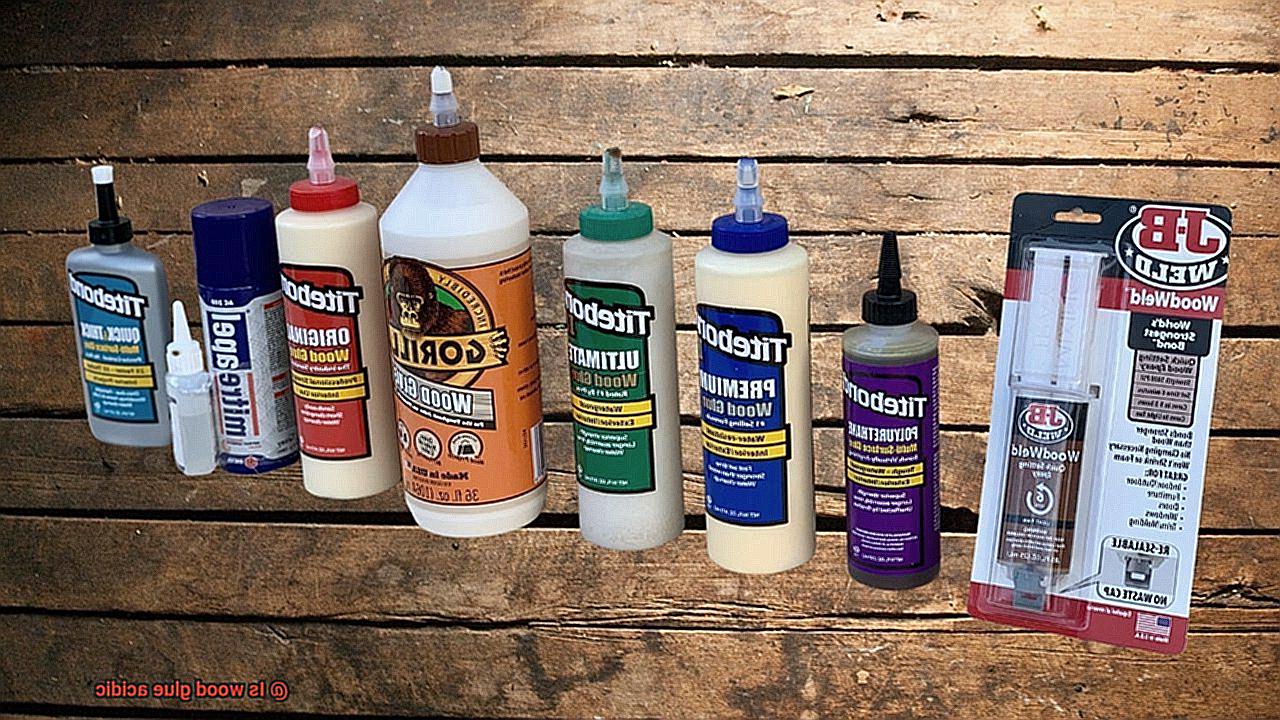
pH level is a measure of acidity or alkalinity. Wood glue, like many other substances, can have different pH levels. Some water-based wood glues might be slightly acidic, while others lean closer to neutral. This pH level plays a vital role in the performance and compatibility of the glue with different types of wood.
Imagine painstakingly crafting a stunning wooden masterpiece, only to see it slowly deteriorate because of acidic glue. Acidic glue can cause corrosion and damage when it interacts with certain types of wood. By measuring the pH level of your wood glue, you can ensure it falls within the desired range for your specific woodworking project.
Measuring the pH level of wood glue is a breeze. You can use a pH meter or pH test strips for an accurate measurement of its acidity or alkalinity. Manufacturers often provide information about the pH level on the product packaging, giving you an idea of its compatibility with different woods.
So, before you embark on your next woodworking adventure, remember to measure the pH level of your wood glue. It’s a simple step that can make a world of difference in guaranteeing the longevity and success of your creations.
Acidity of Wood Glue Compared to Other Substances
Wood glue, a staple in woodworking projects, possesses a fascinating acidity that warrants exploration. With a pH level ranging from 4 to 6, wood glue demonstrates a mild acidity that falls on the acidic side of the pH scale. However, when compared to other commonly used substances, such as vinegar or lemon juice, wood glue pales in comparison in terms of acidity.
Take vinegar, for instance. With its pH level hovering around 2-3, vinegar boasts a much higher acidity than wood glue. This distinction is vital to recognize as the acidity of substances can influence the materials they are applied on. Sensitive surfaces or certain metals may succumb to corrosion or damage when exposed to highly acidic substances. Nevertheless, it is crucial to note that wood glue’s acidity is typically not potent enough to inflict significant harm on most materials.
In fact, the slightly acidic nature of wood glue proves advantageous in the realm of adhesion. By fostering enhanced adhesion between wood surfaces, this mild acidity contributes to robust bonding during woodworking projects, ensuring structural integrity.
It is worth noting that the specific brand or type of wood glue employed can impact its acidity. Manufacturers may utilize diverse ingredients and pH levels in their formulations. To pinpoint the exact acidity of a given wood glue product, reference the packaging or consult the manufacturer’s specifications.
Reason for the Slight Acidity in Wood Glue
Wood glue, a staple in woodworking projects, possesses a unique characteristic that often goes unnoticed – its slight acidity. Have you ever wondered why wood glue has this acidity?
In this article, we will unravel the mystery and delve into the reasons behind the presence of acetic acid in wood glue and how it affects the properties of this adhesive.
Enhancing Bonding Properties:
One of the primary reasons acetic acid is incorporated into wood glue is to improve its bonding properties. Acetic acid acts as a chemical key, unlocking a stronger connection between wooden surfaces.
By breaking down the surface of the wood and creating a rougher texture, acetic acid allows the glue to penetrate more effectively. This intimate contact between the glue and the wood ensures a reliable and long-lasting bond.
So, when you’re working on your woodworking projects, remember that it’s this slight acidity that gives your creations their structural integrity.
Activating the Curing Process:
Acetic acid also plays a crucial role in activating the curing process of wood glue. Just like a catalyst speeding up a reaction, the slight acidity helps the glue dry and harden properly. This accelerated curing process ensures a strong and durable bond between wooden surfaces.
So, when you’re anxiously waiting for your woodworking project to set, remember that it’s the slight acidity in the wood glue that’s working its magic, transforming liquid adhesive into solid strength.
Preventing Microbial Growth:
Another advantage of the slight acidity in wood glue is its ability to prevent microbial growth. The acidic environment created by acetic acid acts as a fortress against bacteria and fungi that could potentially degrade the adhesive over time. This natural defense mechanism significantly prolongs the shelf life of wood glue, making it reliable for future woodworking endeavors. So, when you reach for your trusted bottle of wood glue after months or even years, remember that it’s the slight acidity that’s keeping it fresh and ready to create strong connections once again.
Safety Considerations:
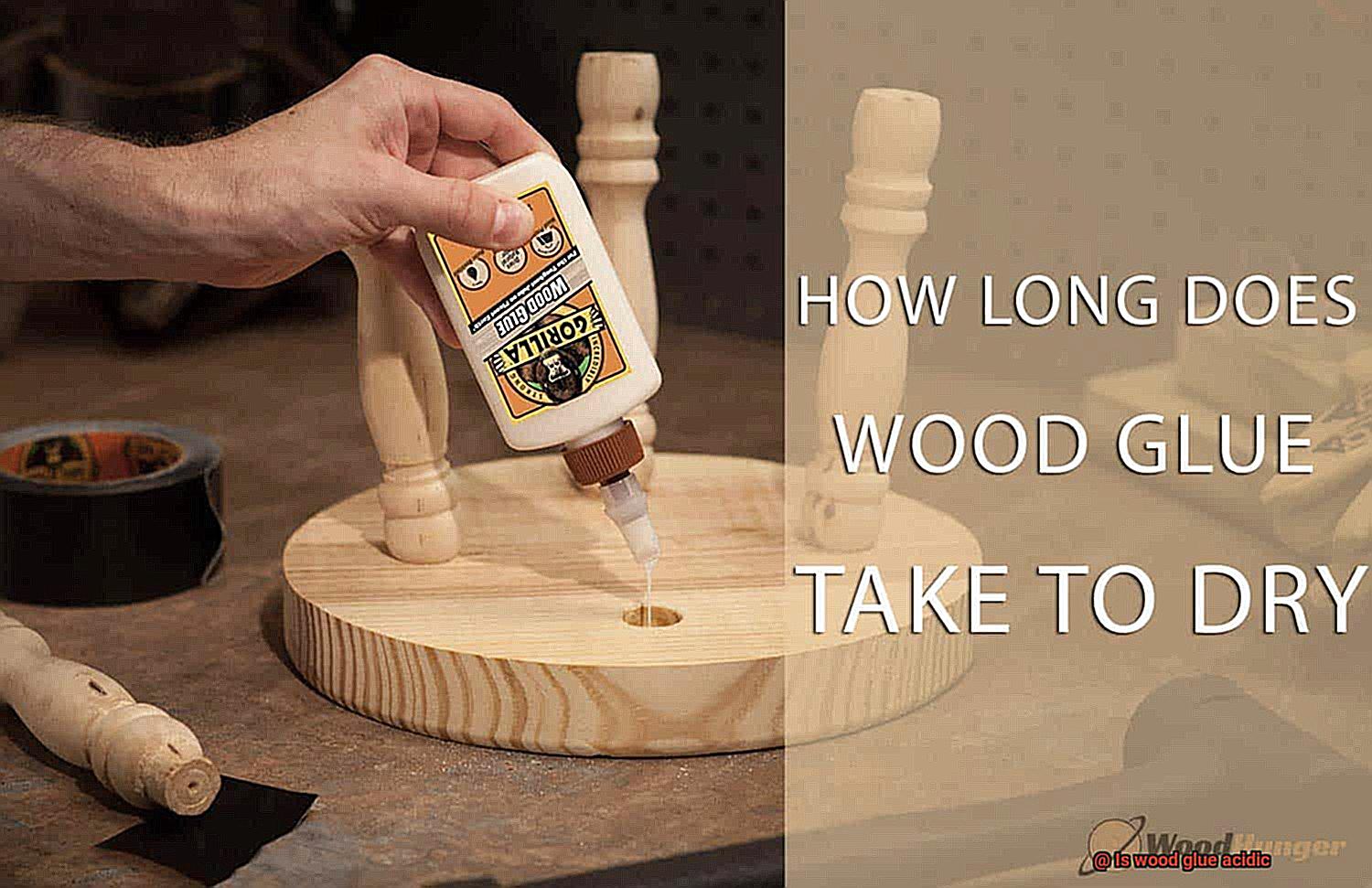
While wood glue’s slight acidity does not pose any significant health risks, it’s essential to prioritize safety when working with any adhesive. Individuals with sensitive skin or respiratory conditions should take extra precautions and wear gloves when using wood glue. Additionally, working in a well-ventilated space can minimize any potential risks associated with prolonged exposure to the slight acidity. So, prioritize your safety and create your woodworking masterpieces with peace of mind.
Does Acidity Affect Woodworking Projects?
Woodworking is a precise and detail-oriented craft that requires careful consideration of every component. One often overlooked factor is the acidity of materials used, particularly wood glue. In this blog post, we will explore the fascinating world of acidity and its effects on woodworking projects, with a specific focus on wood glue.
Acid Staining:
Acidic wood glue can cause an unsightly phenomenon known as acid staining. When the glue’s acidity interacts with tannins in woods like maple or birch, dark or discolored patches may appear on the surface. These blemishes can be a headache for those striving for a flawless finish.
Weakened Bonds:

Acidity in wood glue gradually weakens the bonds between wood pieces over time. The acid content breaks down the adhesive properties, compromising the strength and durability of joints. Imagine spending hours crafting a masterpiece, only to have it fall apart due to weak bonds caused by acidic glue.
Choosing the Right Glue:
To avoid these issues, it is crucial to select wood glue with a neutral pH level. Look for products labeled “acid-free” or “pH neutral” to minimize the risk of acid staining and weakened bonds. Additionally, test any new glue on a scrap piece of wood to ensure compatibility before using it on your project.
Other Sources of Acidity:
Acidity can also come from finishes and solvents used to treat or clean wood. Some of these products contain acids or acidic compounds that react with the wood, causing discoloration and deterioration. Therefore, exercise caution when selecting these materials for your woodworking projects.
Proper Surface Preparation for Adhesive Joints
Today, we’re delving into the world of adhesive joints and uncovering the secrets to creating strong and long-lasting bonds using wood glue. Get ready to unlock the power of proper surface preparation to craft masterpieces that will withstand the test of time.
Step 1: Cleanliness is Paramount
Before even thinking about applying wood glue, ensure that your surfaces are pristine. Eliminate any dirt, dust, or grime that could hinder the bonding process. A simple wipe with a damp cloth will do wonders.
Step 2: Bid Farewell to Old Finishes
Say goodbye to any existing varnish, paint, or wax on your wood surfaces. These sneaky culprits can prevent the glue from forming a robust bond. Use sandpaper or a scraper to completely remove them, leaving behind a smooth and bare surface.
Step 3: Embrace Smoothness
Nobody wants a lumpy joint. Ensure your wood surfaces are flat and even by sanding or planing them. This step not only creates a seamless bond but also eliminates potential weak points in your project.
Step 4: Acclimate Like a Pro
Remember, wood is a living material that absorbs and releases moisture depending on its environment. Allow your wood to adapt by storing it in the same conditions it will be used in. This step ensures that the wood reaches an appropriate moisture content for a formidable bond.
Step 5: Glue Prep 101
Now that your wood is prepared, don’t forget about preparing the adhesive itself. Follow the manufacturer’s instructions carefully, whether you’re using liquid or solid wood glue. Thoroughly mix liquid glue to evenly distribute its components, while solid glue needs to be dissolved in water before use.
Step 6: The Perfect Application
It’s showtime. Apply the glue evenly and thinly onto one of the surfaces using a brush or roller. Avoid excessive amounts of glue, as it can weaken joints. Ensure complete coverage over the entire bonding area, leaving no gaps or missed spots.
Step 7: Apply Pressure
To achieve maximum bonding strength, firmly press the two surfaces together. Clamps or weights can be used to hold them in place while the glue cures. Pay attention to the recommended curing time specified by the manufacturer, as this can vary depending on the type of wood glue used.
Conclusion
In conclusion, wood glue is an indispensable adhesive in the world of woodworking. Its versatility knows no bounds, as it effortlessly forms strong bonds, fills gaps with ease, and withstands the trials of water. While some may argue that wood glue leans towards the acidic side with a pH range of 4 to 7, its acidity is nothing more than a modest whisper that poses no threat to most types of wood.
Surprisingly, this slight acidity actually works in favor of wood glue’s bonding prowess. It allows the adhesive to permeate the surface of the wood with unrivaled efficiency. Thanks to acetic acid, which contributes to this gentle acidity, wood glue not only excels in joining pieces together but also acts as a catalyst for curing and wards off microbial intruders.
Nevertheless, caution must be exercised when working with certain woods like maple or birch. The acidity in wood glue can cause unsightly acid staining on these delicate surfaces. To ensure flawless bonds and avoid any mishaps, it is highly recommended to opt for wood glue with a neutral pH level and diligently prepare your surfaces before applying this adhesive marvel.
In essence, understanding the pH level and acidity of wood glue can mean the difference between mediocre results and masterful craftsmanship.



